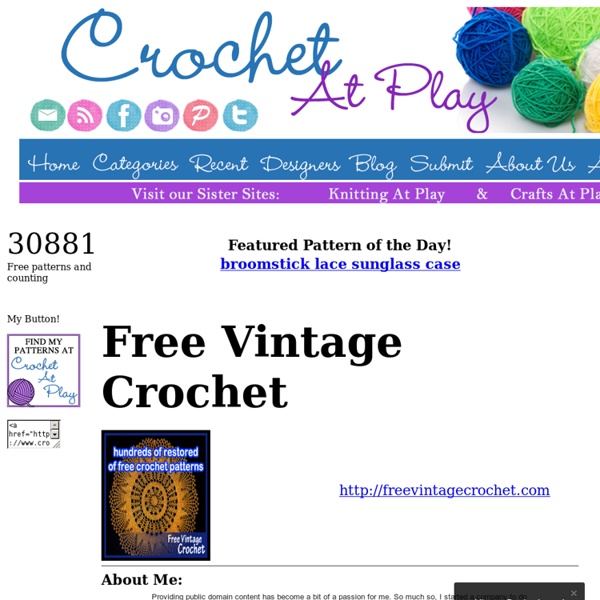



http://www.crochetatplay.com/freevintagecrochet.html
Related: Crochet/Knit/Tat/Embroidery • CrochetRedwork Embroidery and Quilting at Grandma's Attic Redwork History Redwork Embroidery was very popular from about 1880-1920. Patterns were stitched in red (sometimes blue) on a muslin background. This type of stitching, popularized by the Kensington School for Girls in England during the 1880s, was called the Kensington stitch but we know it today as backstitching or outline stitching. The reason Red was chosen is because it was a sturdy cotton thread that could be counted on not to fade or bleed. Totoro Amigurumi Crochet Pattern - Free - Ami Amour I finally got the chance to write up this free Totoro amigurumi crochet pattern. I hope you guys will enjoy! Totoro was first introduced in Hayao Mikazaki’s animated film My Neighbor Totoro (1988). He’s a forest spirit that comes to the comfort of two little girls when their mother is sick and he takes them on a great adventure and shows them the beauty and wonder of the forest. The gray Totoro is the one best known, but there’s also a smaller blue Totoro (aka Chu Totoro) and a white chibi Totoro. The blue Totoro likes to collect acorns and carry them in his knapsack.
hardanger embroidery Site Map Pulled Thread Work Drawn Thread Work bobbin lace Needlelace Filet Lacis & Teneriffe Hardanger embroidery is a form of drawn thread work in which small rectangular sections of cloth are stabilized by satin stitching, cut out and then embellished. It is a combination of drawn thread and cutwork (punto tagliato). Designs are always geometric, and traditional designs are nearly always symmetrical. Crochet 3D Rose Flowers Free Patterns & Tutorials 12. Crochet 3D Rose Flower with Leaf Image and Free Patterns: Blog Naver & Leaf Pattern Basic Crewel Embroidery Stitches The basic embroidery stitches used in crewelwork form the foundation of many other embroidery methods. Crewel is a freeform embroidery worked on non-evenweave fabrics and therefore it requires a sharp embroidery needle. You can use any thread for stitching, even thicker ones such as all 6 strands of embroidery floss. The stitches form bold, heavy work. Use fabric heavy enough to support the work.
Attic24: May Roses This is my pattern for these adorable May Roses, a sweet little floral decoration for all sorts of prettifying projects. Make them into brooches, attach them to hats, bags, hair slides, cardigans. Assemble a whole bunch of them to prettify a tea cosy, a bag, a cushion. String them together to make a pretty floral garland. Stitch them to crochet triangles to make some pretty rosy bunting. Glue them to a twiggy wreath to make a gorgeous decoration for your home.......ahhh so many fun possibilities!
Candlewick Embroidery « Save the Stitches! In researching this technique, it is generally agreed that it was created in America by the women who traveled out to the wild and untamed west. The first traders along the way carried a few basic sewing necessities, just enough to mend a pair of britches so they might last another season. The adventurous women were who went west had to bring what they could in a covered wagon or on a pack animal. That didn’t allow for extras or for fancy things. 16 Free Crochet Doily Patterns Crochet is so vast and there are so many crochet techniques to learn. Knowing how to crochet doilies takes determination, patience, and skill. It’s definitely more intricate work when it comes to crochet patterns. Doilies are crocheted in the round, making them a rhythmic and relaxing crochet project – perfect when you need a little zen time. Crochet doilies use various crochet hook sizes, often on the smaller end of the scale. If you enjoy detailed work or just want to try something different, these 16 free crochet patterns are a great place to start – some are vintage crochet patterns, others modern.
Over 300 Free Tatting Patterns and Projects, How To Tatting Guides, Charts and More at AllCrafts! Online Since 2000 FreeCrafts Free Holiday Crafts Imagine Imagine is a 12 inch afghan block inspired by, unsurprisingly, a song! Pattern written in US crochet terms Skill level: advanced Finished Size: 12 inch square Free Plastic Canvas Patterns at www.allcrafts.net Online Since 2000 FreeCrafts Free Holiday Crafts Sewing & Quilting Crochet & Knitting